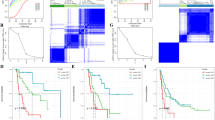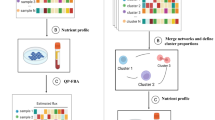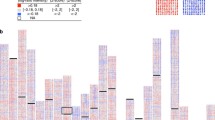Abstract
Purpose
Cancer cells maintain cell growth, division, and survival through altered energy metabolism. However, research on metabolic reprogramming in lung adenocarcinoma (LUAD) is limited
Methods
We downloaded TCGA and GEO sequencing data. Consistent clustering with the ConsensusClusterPlus package was employed to detect the scores for four metabolism-related pathways. The LUAD samples in the TCGA dataset were clustered with ConsensusClusterPlus, and the optimal number of clusters was determined according to the cumulative distribution function (CDF). The cell score for each sample in the TCGA dataset was calculated using the MCPcounter estimate function of the MCPcounter package.
Results
We identified two subtypes by scoring the samples based on the 4 metabolism-related pathways and cluster dimensionality reduction. The prognosis of cluster B was obviously poorer than that of cluster A in patients with LUAD. The analysis of single-nucleotide variation (SNV) data showed that the top 15 genes in the four metabolic pathways with the most mutations were TKTL2, PGK2, HK3, EHHADH, GLUD2, PKLR, TKTL1, HADHB, CPT1C, HK1, HK2, PFKL, SLC2A3, PFKFB1, and CPT1A. The IFNγ score of cluster B was significantly higher than that of cluster A. The immune T-cell lytic activity score of cluster B was significantly higher than that of cluster A. We further identified 5 immune cell subsets from single-cell sequencing data. The top 5 marker genes of B cells were IGHM, JCHAIN, IGLC3, IGHA1, and IGKC. The C0 subgroup of monocytes had a higher pentose phosphate pathway (PPP) score than the C6 subgroup.
Conclusions
Metabolism-related subtypes could be potential biomarkers in the prognosis prediction and treatment of LUAD.








Similar content being viewed by others
Data availability
The datasets analyzed during the current study are available from the corresponding authors on reasonable request.
References
Kaira K, Yanagitani N, Sunaga N, Imai H, Ono A, Koga Y, et al. Prospective exploratory study of gemcitabine and S-1 against elderly patients with advanced non-small cell lung cancer. Oncol Lett. 2017;14(1):1123–8.
Pan D, Chen J, Feng C, Wu W, Wang Y, Tong J, et al. Preferential localization of MUC1 glycoprotein in exosomes secreted by non-small cell lung carcinoma cells. Int J Mol Sci. 2019;20(2):323.
Hu X, Yang F, Liao Y, Li L, Zhao G, Zhang L. Docetaxel-loaded cholesterol-PEG Co-modified poly (n-Butyl) cyanoacrylate nanoparticles for antitumor drug pulmonary delivery: preparation, characterization, and in vivo evaluation. Int J Nanomed. 2020;15:5361–76.
Xing Y, Lin Y, Zhang Y, Hu J, Liu J, Tian Y, et al. Novel cytoplasmic lncRNA IKBKBAS promotes lung adenocarcinoma metastasis by upregulating IKKβ and consequential activation of NF-κB signaling pathway. Cell Death Dis. 2021;12(11):1004.
Yu J, Hu Y, Xu Y, Wang J, Kuang J, Zhang W, et al. LUADpp: an effective prediction model on prognosis of lung adenocarcinomas based on somatic mutational features. BMC Cancer. 2019;19(1):263.
Lou X, Wang JJ, Wei YQ, Sun JJ. Emerging role of RNA modification N6-methyladenosine in immune evasion. Cell Death Dis. 2021;12(4):300.
Kamarajugadda S, Stemboroski L, Cai Q, Simpson NE, Nayak S, Tan M, et al. Glucose oxidation modulates anoikis and tumor metastasis. Mol Cell Biol. 2012;32(10):1893–907.
de Mey S, Dufait I, Jiang H, Corbet C, Wang H, Van De Gucht M, et al. Dichloroacetate radiosensitizes hypoxic breast cancer cells. Int J Mol Sci. 2020;21(24):9367.
Tomaszowski KH, Hellmann N, Ponath V, Takatsu H, Shin HW, Kaina B. Uptake of glucose-conjugated MGMT inhibitors in cancer cells: role of flippases and type IV P-type ATPases. Sci Rep. 2017;7(1):13925.
Saggese P, Sellitto A, Martinez CA, Giurato G, Nassa G, Rizzo F, et al. Metabolic regulation of epigenetic modifications and cell differentiation in cancer. Cancers. 2020;12(12):3788.
Pan T, Liu J, Xu S, Yu Q, Wang H, Sun H, et al. ANKRD22, a novel tumor microenvironment-induced mitochondrial protein promotes metabolic reprogramming of colorectal cancer cells. Theranostics. 2020;10(2):516–36.
Sáenz-de-Santa-María I, Bernardo-Castiñeira C, Secades P, Bernaldo-de-Quirós S, Rodrigo JP, Astudillo A, et al. Clinically relevant HIF-1α-dependent metabolic reprogramming in oropharyngeal squamous cell carcinomas includes coordinated activation of CAIX and the miR-210/ISCU signaling axis, but not MCT1 and MCT4 upregulation. Oncotarget. 2017;8(8):13730–46.
Ekici S, Risk BB, Neill SG, Shu HK, Fleischer CC. Characterization of dysregulated glutamine metabolism in human glioma tissue with (1)H NMR. Sci Rep. 2020;10(1):20435.
Bernhardt S, Bayerlová M, Vetter M, Wachter A, Mitra D, Hanf V, et al. Proteomic profiling of breast cancer metabolism identifies SHMT2 and ASCT2 as prognostic factors. Breast Cancer Res. 2017;19(1):112.
Yu TJ, Ma D, Liu YY, Xiao Y, Gong Y, Jiang YZ, et al. Bulk and single-cell transcriptome profiling reveal the metabolic heterogeneity in human breast cancers. Mol Ther. 2021;29(7):2350–65.
Bidkhori G, Benfeitas R, Klevstig M, Zhang C, Nielsen J, Uhlen M, et al. Metabolic network-based stratification of hepatocellular carcinoma reveals three distinct tumor subtypes. Proc Natl Acad Sci U S A. 2018;115(50):E11874-e83.
Liu X, Wu A, Wang X, Liu Y, Xu Y, Liu G, et al. Identification of metabolism-associated molecular subtype in ovarian cancer. J Cell Mol Med. 2021;25(20):9617–26.
Subramanian A, Tamayo P, Mootha VK, Mukherjee S, Ebert BL, Gillette MA, et al. Gene set enrichment analysis: a knowledge-based approach for interpreting genome-wide expression profiles. Proc Natl Acad Sci U S A. 2005;102(43):15545–50.
Mootha VK, Lindgren CM, Eriksson KF, Subramanian A, Sihag S, Lehar J, et al. PGC-1alpha-responsive genes involved in oxidative phosphorylation are coordinately downregulated in human diabetes. Nat Genet. 2003;34(3):267–73.
Plaisier SB, Taschereau R, Wong JA, Graeber TG. Rank-rank hypergeometric overlap: identification of statistically significant overlap between gene-expression signatures. Nucleic Acids Res. 2010;38(17):e169.
Wang F, Xu X, Zhang N, Chen Z. Identification and integrated analysis of hepatocellular carcinoma-related circular RNA signature. Ann Transl Med. 2020;8(6):294.
Bhuva DD, Foroutan M, Xie Y, Lyu R, Cursons J, Davis MJ. Using singscore to predict mutation status in acute myeloid leukemia from transcriptomic signatures. F1000Res. 2019;8:776.
Chen K, Zeng J, Xiao H, Huang C, Hu J, Yao W, et al. Regulation of glucose metabolism by p62/SQSTM1 through HIF1α. J Cell Sci. 2016;129(4):817–30.
Shang R, Wang M, Dai B, Du J, Wang J, Liu Z, et al. Long noncoding RNA SLC2A1-AS1 regulates aerobic glycolysis and progression in hepatocellular carcinoma via inhibiting the STAT3/FOXM1/GLUT1 pathway. Mol Oncol. 2020;14(6):1381–96.
Gao J, Wan C, Zhang H, Li A, Zang Q, Ban R, et al. Anaconda: AN automated pipeline for somatic copy number variation detection and annotation from tumor exome sequencing data. BMC Bioinform. 2017;18(1):436.
Guevara-Patiño JA, Engelhorn ME, Turk MJ, Liu C, Duan F, Rizzuto G, et al. Optimization of a self antigen for presentation of multiple epitopes in cancer immunity. J Clin Invest. 2006;116(5):1382–90.
Chen T, Guo J, Cai Z, Li B, Sun L, Shen Y, et al. Th9 cell differentiation and its dual effects in tumor development. Front Immunol. 2020;11:1026.
Takikawa O, Tagawa Y, Iwakura Y, Yoshida R, Truscott RJ. Interferon-gamma-dependent/independent expression of indoleamine 2,3-dioxygenase. Studies with interferon-gamma-knockout mice. Adv Exp Med Biol. 1999;467:553–7.
Garcia-Diaz A, Shin DS, Moreno BH, Saco J, Escuin-Ordinas H, Rodriguez GA, et al. Interferon receptor signaling pathways regulating PD-L1 and PD-L2 expression. Cell Rep. 2017;19(6):1189–201.
Zhang R, Liu H, Li F, Li H, Yu J, Ren X. The correlation between the subsets of tumor infiltrating memory T cells and the expression of indoleamine 2,3-dioxygenase in gastric cancer. Dig Dis Sci. 2013;58(12):3494–502.
Chen JY, Li CF, Kuo CC, Tsai KK, Hou MF, Hung WC. Cancer/stroma interplay via cyclooxygenase-2 and indoleamine 2,3-dioxygenase promotes breast cancer progression. Breast Cancer Res. 2014;16(4):410.
McLean I. Assessment of the acute knee injury. Aust Fam Physic. 1984;13(8):575–80.
Wu X, Liu T, Gao S, Chen S, Lu Q. Single polar cell trapping based on the breath figure method. ACS Omega. 2019;4(23):20223–9.
Mitra R, Goodman OB, Le TT. Enhanced detection of metastatic prostate cancer cells in human plasma with lipid bodies staining. BMC Cancer. 2014;14(1):1–2.
Xiao Z, Dai Z, Locasale JW. Metabolic landscape of the tumor microenvironment at single cell resolution. Nat Commun. 2019;10(1):3763.
Shinohara H, Sugito N, Kuranaga Y, Heishima K, Minami Y, Naoe T, et al. Potent antiproliferative effect of fatty-acid derivative AIC-47 on leukemic mice harboring BCR-ABL mutation. Cancer Sci. 2019;110(2):751–60.
Zhu Z, Qin J, Dong C, Yang J, Yang M, Tian J, et al. Identification of four gastric cancer subtypes based on genetic analysis of cholesterogenic and glycolytic pathways. Bioengineered. 2021;12(1):4780–93.
Zhu X, Li J, Li HD, Xie M. Wang J. Sc-GPE: A Graph Partitioning-Based Cluster Ensemble Method for Single-Cell. Front Genet; 2020. p. 11604790.
Guo X, Zhang Y, Zheng L, Zheng C, Song J, Zhang Q, et al. Global characterization of T cells in non-small-cell lung cancer by single-cell sequencing. Nat Med. 2018;24(7):978–85.
He D, Wang D, Lu P, Yang N, Xue Z, Zhu X, et al. Single-cell RNA sequencing reveals heterogeneous tumor and immune cell populations in early-stage lung adenocarcinomas harboring EGFR mutations. Oncogene. 2021;40(2):355–68.
Kikuchi R, Iwai Y, Tsuji T, Watanabe Y, Koyama N, Yamaguchi K, et al. Hypercapnic tumor microenvironment confers chemoresistance to lung cancer cells by reprogramming mitochondrial metabolism in vitro. Free Radic Biol Med. 2019;134:200–14.
Zhou W, Zhang J, Marcus AI. LKB1 tumor suppressor: therapeutic opportunities knock when LKB1 Is inactivated. Genes Dis. 2014;1(1):64–74.
Just PA, Poncy A, Charawi S, Dahmani R, Traore M, Dumontet T, et al. LKB1 and notch pathways interact and control biliary morphogenesis. PLoS One. 2015;10(12):e0145400.
Granado-Martínez P, Garcia-Ortega S, González-Sánchez E, McGrail K, Selgas R, Grueso J, et al. STK11 (LKB1) missense somatic mutant isoforms promote tumor growth, motility and inflammation. Commun Biol. 2020;3(1):366.
Bonanno L, Zulato E, Pavan A, Attili I, Pasello G, Conte P, et al. LKB1 and tumor metabolism: the interplay of immune and Angiogenic microenvironment in lung cancer. Int J Mol Sci. 2019;20(8):1874.
Funding
This work was funded by Henan Medical Science and Technology Joint Building Program (LHGJ20210308 and LHGJ20210328).
Author information
Authors and Affiliations
Contributions
YZ and LZ conceived and planned the study design; JS and YZ performed formal analysis and data interpretation; JL and YZ wrote the original draft; CL provided critical revisions and contributed to the editing of the paper. All authors read and approved the final manuscript.
Corresponding authors
Ethics declarations
Conflict of interest
The authors have no conflict of interests related to this publication.
Ethical approval
The study has been performed in accordance with the ethical standards as laid down in the 1964 Declaration of Helsinki and its later amendments.
Informed consent
For this type of study, formal consent is not required.
Additional information
Publisher's Note
Springer Nature remains neutral with regard to jurisdictional claims in published maps and institutional affiliations.
Supplementary Information
Below is the link to the electronic supplementary material.
12094_2023_3082_MOESM1_ESM.tif
Supplementary file1 Differential genes and scores of metabolic subtypes in the GSE31210 dataset. A: Differential gene analysis of the two subtypes with respect to the four metabolism-related pathways in the GSE31210 dataset and heatmap of the four metabolism-related pathway scores (TIF 4351 KB)
12094_2023_3082_MOESM2_ESM.tif
Supplementary file2 Differential genes and scores of metabolic subtypes in the GSE50081 dataset. A: Differential gene analysis of the four metabolism-related pathways and heatmap of the four metabolism-related pathway scores for the two subtypes in the GSE50081 dataset (TIF 3337 KB)
12094_2023_3082_MOESM3_ESM.tif
Supplementary file3 Comparison of clinical features of metabolism-related subtypes. A: Comparison of different clinical features between the two molecular subtypes in the TCGA dataset. B: Comparison of different clinical features between the two molecular subtypes in the GSE31210 dataset. C: Comparison of different clinical features between the two molecular subtypes in the GSE50081 dataset (TIF 2624 KB)
12094_2023_3082_MOESM4_ESM.tif
Supplementary file4 The scores of immune cell, IFNγ, and immune T-cell lytic activity for metabolism-related subtypes in the GSE31210 dataset. A: Differences in immune cell scores predicted by MCPcounter between the two subtypes in the GSE31210 dataset. B: Difference in IFNγ score between the two subtypes in the GSE31210 dataset. C: Difference in immune T-cell lytic activity score between the two subtypes in the GSE31210 dataset (TIF 1035 KB)
12094_2023_3082_MOESM5_ESM.tif
Supplementary file5 The scores of immune cell, IFNγ, and immune T-cell lytic activity for metabolism-related subtypes in the GSE50081 dataset. A: Differences in immune cell scores predicted by MCPcounter between the two subtypes in the GSE50081 dataset. B: Difference in the IFNγ score between the two subtypes in the GSE50081 dataset. C: Difference in immune T-cell lytic activity score between the two subtypes in the GSE50081 dataset (TIF 947 KB)
12094_2023_3082_MOESM7_ESM.tif
Supplementary file7 Analysis of the relationship between hypoxia type score, angiogenesis score, immune cells and metabolism-related subtypes A: Correlation analysis of the hypoxia type score and the four metabolism-related pathway scores. B: Correlation analysis of the angiogenesis score and the four metabolism-related pathway scores. C: Differential analysis of the metabolism-related subtypes in different cell types. D: Correlations of monocytes with the hypoxia score, angiogenesis score and four metabolism-related pathway scores (TIF 5595 KB)
Rights and permissions
Springer Nature or its licensor (e.g. a society or other partner) holds exclusive rights to this article under a publishing agreement with the author(s) or other rightsholder(s); author self-archiving of the accepted manuscript version of this article is solely governed by the terms of such publishing agreement and applicable law.
About this article
Cite this article
Zhang, Y., Shi, J., Luo, J. et al. Metabolic heterogeneity in early-stage lung adenocarcinoma revealed by RNA-seq and scRNA-seq. Clin Transl Oncol 25, 1844–1855 (2023). https://doi.org/10.1007/s12094-023-03082-z
Received:
Accepted:
Published:
Issue Date:
DOI: https://doi.org/10.1007/s12094-023-03082-z




